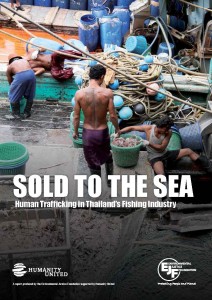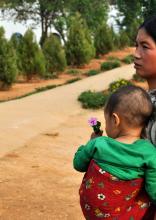Resources (827 found)
Protecting Minority Rights Is Non-Negotiable
In its rush to normalize relations with Myanmar, the international community – particularly the United Nations – must not ignore the increase in abuses being committed against ethnic minorities in Rakhine and Kachin States, and it must take a stronger stance in defense of the human rights of affected populations. Ten months after violence forced them into displacement […]
• • •Presentation on Recent Developments on Myanmar National Human Rights Commission (MNHRC) Complaints Handling, Investigations and Cooperation with the Special Procedures of the United Nations
A presentation by Win Mra on developments with the MNHRC in 2012, as well as how protection works through the MNHRC’s complaints handling mechanism and the difficulties that are impeding the progress in this aspect […]
• • •Sold to the Sea: Human Trafficking in Thailand’s Fishing Industry
 Human trafficking is a global problem. It is estimated that as many as 27 million men, women and children are currently victims of human trafficking around the world.
Human trafficking is a global problem. It is estimated that as many as 27 million men, women and children are currently victims of human trafficking around the world.
Thailand is the 32nd largest economy in the world, with a GDP of $377 billion and a growth rate of 5.5 per cent in 2012.2/3 It also has one of the lowest unemployment rates globally, at 0.5 per cent in December 2012.
Thailand’s economy is heavily reliant on labour-intensive industries. However, growing economic prosperity since the late 1980s has seen a decline in the available Thai workforce needed to meet the labour demand.5 In 2009, Thailand’s Ministry of Labour estimated that an additional 116,000 workers would be needed to address the labour-market imbalance […]
• • •Annual Report 2013: Myanmar
Amid ongoing political, legal and economic reforms, the authorities released hundreds of prisoners of conscience; however, many remained behind bars. Security forces and other state agents continued to commit human rights violations, including unlawful killings, excessive use of force, arbitrary arrests, torture and other ill-treatment, and unlawful confiscation […]
• • •Briefing for the Security Council Working Group on Children and Armed Conflict Regarding the Recruitment and Use of Child Soldiers in Burma (Myanmar) and Implementation of the Joint Action Plan
Human Rights Watch has monitored the human rights situation in Burma (Myanmar) for 25 years, including violations against children affected by armed conflict. We have conducted two in-depth investigations of recruitment and use of child soldiers by both government forces and non-state armed groups, publishing our findings in My Gun was as Tall as Me: Child Soldiers in Burma in 2002 […]
• • •Burma’s Forgotten Political Prisoners
This briefing paper contains case studies of 6 political prisoners who were arbitrarily arrested by the military-backed government in Burma. It also looks at how the review committee for political prisoners set up by the Burmese government is flawed, highlights the continued existence of almost all repressive laws, and how the release of political prisoners has been tactically used by the Burmese government to persuade […]
• • •Massacre in Central Burma Muslim Students Terrorized and Killed in Meiktila
This report details the results of a PHR investigation into the March 20 and 21, 2013, attacks on Muslim students, teachers, and residents in the Mingalar Zayyone quarter of Meiktila, a small town in central Burma. A two-person team from PHR conducted 33 interviews about the attacks, which resulted in the deaths of at least 20 children and four teachers […]
• • •Reforming Telecommunications in Burma
In January 2013, the Burmese government announced plans to liberalize the country’s telecommunications sector and invited bids for two nationwide telecommunications licenses.[1] Successful bidders will be allowed to provide a range of services, including mobile and Internet services […]
• • •The Revenue Watch 2013 Resource Governance Index
The Resource Governance Index (RGI) measures the quality of governance in the oil, gas and mining sector of 58 countries. From highly ranked countries like Norway, the United Kingdom and Brazil to lowranking countries like Qatar, Turkmenistan and Myanmar, the Index identifies […]
• • •Access Denied: Land Rights and Ethnic Conflict in Burma
 The reform process in Burma/Myanmar1 by the quasi-civilian government of President Thein Sein has raised hopes that a long overdue solution can be found to more than 60 years of devastating civil war. Burma’s ethnic minority groups have long felt marginalized and discriminated against, resulting in a large number of ethnic armed opposition groups fighting the central government – dominated by the ethnic Burman majority – for ethnic rights and autonomy. The fighting has taken place mostly in Burma’s borderlands where ethnic minorities are most concentrated […]
The reform process in Burma/Myanmar1 by the quasi-civilian government of President Thein Sein has raised hopes that a long overdue solution can be found to more than 60 years of devastating civil war. Burma’s ethnic minority groups have long felt marginalized and discriminated against, resulting in a large number of ethnic armed opposition groups fighting the central government – dominated by the ethnic Burman majority – for ethnic rights and autonomy. The fighting has taken place mostly in Burma’s borderlands where ethnic minorities are most concentrated […]









 All posts
All posts